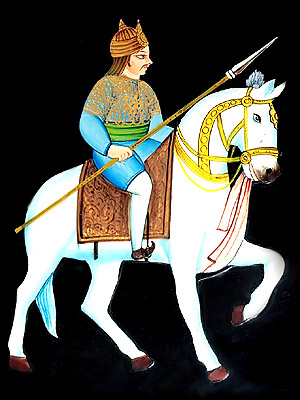 Vishnukundina Empire played an important role in the history of the Deccan during the 5th and 6th centuries CE. It is believed that they were one of the ancestors of Pusapatis of Vizianagaram and three other clans of Kshatriya Raju caste in Andhra Pradesh. The rule of Vishnukundin Empire came to an end with the conquest of the eastern Deccan by the Chalukyan, Pulakesin II. He appointed his brother Kubja Vishnuvardhana as Viceroy to rule over the conquered lands. Vishnuvardhana declared his independence and started the Eastern Chalukya dynasty.
Vishnukundina Empire played an important role in the history of the Deccan during the 5th and 6th centuries CE. It is believed that they were one of the ancestors of Pusapatis of Vizianagaram and three other clans of Kshatriya Raju caste in Andhra Pradesh. The rule of Vishnukundin Empire came to an end with the conquest of the eastern Deccan by the Chalukyan, Pulakesin II. He appointed his brother Kubja Vishnuvardhana as Viceroy to rule over the conquered lands. Vishnuvardhana declared his independence and started the Eastern Chalukya dynasty.
Origin of Vishnukundina Dynasty
The Sanskrit name for Vishnukonda is Vishnukundina. The origin of this dynasty is shrouded in mystery. One theory states that they belong to Koundinya of Kshatriyas who migrated from Ayodhya during the early 5th century. During the rule of Madhava Varma they became independent and conquered coastal Andhra from the Salankayanas.
It is estimated that the Vishnukudins ruled between the end of the Salankayana and the rise of the Eastern Chalukyan power in 624 AD.
Kings of Vishnukundina Empire
According to some inscriptions Indra Varma is the first ruler of the Vishnukundin dynasty. It is believed that he carved out a small princedom for himself possibly as a subordinate of the Vakatakas in the last quarter of the fourth century C.E.
Madhav Varma I
I
Under rule of Madhav Varma II the dynasty began its imperial expansion who ruled for nearly half a century. His reign is considered as a golden age in the history of the Vishnukundins. During his rule Vishnukundin dynasty rose to great heights. A princess of the Vakataka dynasty was given in marriage to Madhav Varma`s son, Vikramendra Varma.
This increased the power of the Vishnukundina dynasty. He occupied the areas of Guntur, Tenali and Ongole. Thereafter he made Amarapura his capital.
Madhav Varma II annexed the Vengi kingdom that was ruled by Salankayanas. Godavari tract became part of the Vishnukundin territory. Post conquests he performed sacrifices like Asvamedha, Rajasuya and other Vedic sacrifices.
During the rule of Vikramendra Varma I (508-528 C.E.) Vishnukundina dynasty lost its power. The next two and half decade witnessed constant dynastic struggles during the rule of Indra Bhattaraka Varma (528-555 C.E.). The dynasty lost Kalinga.
Vikramendra Varma II
After Vikramendra Varma II took over, the Vishnukundin family were able to restore their power. He shifted his capital from Bezwada to Lenduluru in order to remain close to Kalinga. He restored the fortunes of the Vishnukundins in the Kalinga region.
Govinda Varma II (569-573 C.E.)
Vishnukundina Empire expanded under its able ruler Janssraya Madhav Varma IV (573-621 A.D.). He consolidated his position in Vengi. He suppressed the upheaval of his subordinate chief the Durjaya Prithvi Maharaja in Guddadivishya.
Madhav Varma IV had to face the Chalukyan assault in his last years of rule. It is believed that Madhava`s son Manchana Bhattaraka might have been expelled by the Chalukyas.
Vishnukundina dynasty declined by the end of 624 A.D.



















